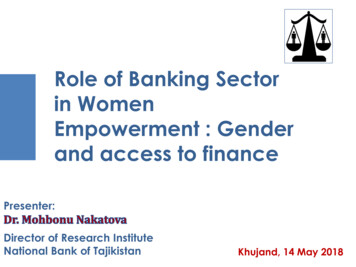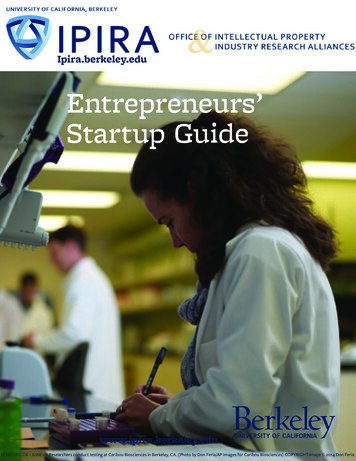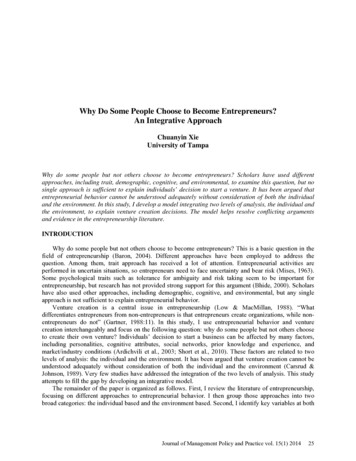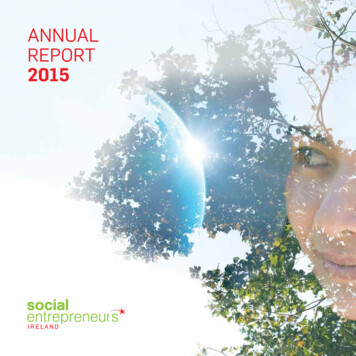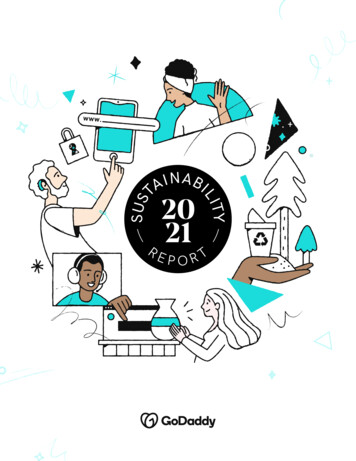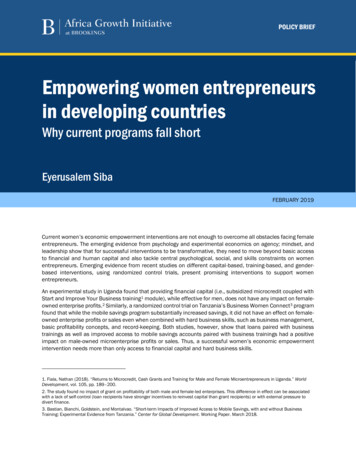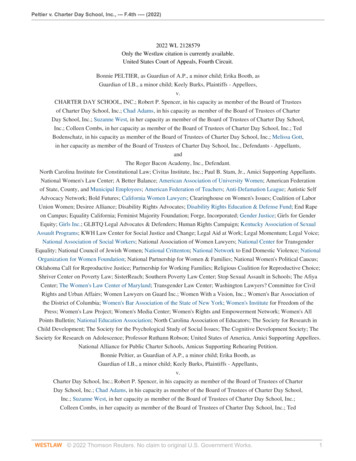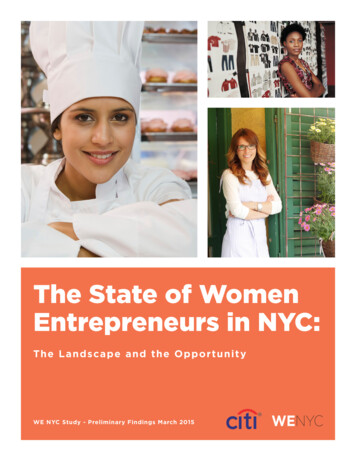
Transcription
The State of WomenEntrepreneurs in NYC:The L and s c a p e a nd the OpportunityWE NYC Study - Preliminary Findings March 2015
Introducing WE NYCA First-of-its-Kind Model for EmpoweringWomen Through EntrepreneurshipThe New York City Department of Small Business Services (SBS)has identified women’s entrepreneurship as a key driver ofeconomic development in the city. In March 2015, SBS announcedthe creation of WE NYC, a new initiative focusing on two maingoals: Increasing income stability for women and families bysupporting entrepreneurship as an opportunity forsupplementary income and as a pathway for long-termeconomic security Strengthening the economic impact of women entrepreneursby facilitating the growth of their companies to increaseinvestment and create jobs in New York CityWE NYC will be a first-of-its kind model in a major American cityfor empowering women through entrepreneurship across a widearray of sectors. By addressing key challenges to entrepreneurshipthrough a comprehensive suite of innovative programs andstrategies, and by tapping into the expertise and support of adiverse set of public, private, nonprofit, and philanthropicpartners, WE NYC aims to lift up thousands of New York Citywomen, and with them families and entire communities.1
The PromiseEntrepreneurshipThestate ofof women’s entrepreneurshipin NYC, the promise and the challengesThe economic power of women in the United States isundeniable and well-documented. Women account for 53percent of college graduates.1 They constitute 47 percent ofthe labor force,2 control slightly more than half (51 percent) ofall personal wealth, and 73 percent of total householdspending.3Despite the advances women have made in education andworkforce participation, they still face a variety of challenges.Many women struggle to find flexible arrangements oradequate pay, unemployment and underemployment remainhigh, and nearly 18 million women live in poverty in the UnitedStates.4This landscape mirrors the situation for the 4 million womenand girls who live New York City where one in four areconsidered economically vulnerable. Close to 40 percent ofthe households headed by a single mother are impoverished.5The unemployment rate for New York City women isapproximately 6 percent, but in neighborhoods with highconcentrations of poverty, the rate can be as high as 40percent.6Erika NazarioMio Mucaro – BrooklynHome made dolls sold on Etsy.comTime in Business: One yearMotivation: Contribute to the household income while raisingher child and doing something she is passionateabout Leverage her design education and experience asa mother to create beautiful dollsChallenges: Taking advantage of resources available forwomen entrepreneurs proved to be difficult whentrying to balance family commitments Finding her way through the maze of availablebusiness resources “there is no one stop shop”Something unique: Erika learned how to sew from her grandmothersin Puerto Rico where she was born Her dolls are all hand-sewn and made fromeco-friendly non-allergenic materials In just six months Erika sold over 100 dollsMeanwhile, entrepreneurship could be a pathway to incomestability and long-term economic security. A zip code levelanalysis of New York City neighborhoods indicates a positivecorrelation between self-employment and per capita income.In top quartile neighborhoods where self-employment is high(5.7 percent of population), the average per capita income is 64,000 compared to the bottom quartile where selfemployment is low (2 percent) and per capita income is 26,000.7 In addition to the economic security thatentrepreneurship can bring to individuals and their families, it can also serve to lift up communities through jobcreation.8As an added benefit, women entrepreneurs seem to have a greater quality of life. A recent study by the GlobalEntrepreneurship Monitor found that entrepreneurs in general are happier than the general population, and thatwomen entrepreneurs rate their happiness higher than their counterparts in traditional employment.9However, women face a variety of challenges when they pursue entrepreneurship: less access to capital thanmen, less training and education, fewer support systems, and latent discrimination that can hamper their success.It is in this context that the New York City Department of Small Business Services (SBS) is launching WomenEntrepreneurs New York City (WE NYC). WE NYC will focus on identifying the needs of women entrepreneurs toscale existing programs or create new ones to unlock the full economic potential of women.This paper highlights the preliminary findings of a study currently being conducted by SBS to better understandthe landscape of women entrepreneurs in New York City, the challenges they face, and the areas where theywould benefit most from the City’s assistance. The full report will be published later this year.1. US Census Bureau, 20142. United States Department of Labor, 20123. The Women-Led Economy, U.S. Women’s Chamber of Commerce4. National Women’s Law Center analysis of Census data, 20145/6. Economic Security and Well-Being Index for Women in New York City, New York City Women’s Foundation, 20137. U.S. Census American Community Survey, U.S. Census Bureau Census ZIP Code Business Patterns, A.T. Kearney Analysis; Note:Self-employment is calculated based on population above the age of 168. Launching Low Income Entrepreneurs, the Center for an Urban Future, 20139. Global Report, Global Entrepreneurship Monitor, 20132
WomenEntrepreneursCity: The LandscapeThestateof women’in New Yorks entrepreneurshipin NYC, the promise and the challengesNew York City is home to approximately 359,000 women entrepreneur businesses representing 32 percent of allregistered companies in the city—an increase of 43 percent since 2002 (see methodology side bar on followingpage).10 To fully evaluate the landscape and its dynamics, it is important to understand the makeup andcharacteristics of women entrepreneur businesses.The largest and fastest-growing segment of women entrepreneurs are “non-employer” businesses (i.e. selfemployed women). Ninety-two percent of women entrepreneur businesses in New York City fall into thissegment. These companies average 32,000 per year in annual business income—as much as 34 percent belowNew York City’s median individual income.11 Citywide among women and men, the number of non-employerbusinesses has exploded in recent years. Strikingly, since 2002 the number of non-employer womenentrepreneur businesses has increased 48 percent, compared to a 36 percent rise among their malecounterparts (see figure 1).Figure 1: Growth rate in number of Businesses - NYC 2002-2014Source: US. Census Bureau Survey of Business Owners 2002, 2007 data; A.T. Kearney analysisThe other 8 percent, or roughly 30,000 businesses, are classified as “employer businesses.” These are womenentrepreneurs who operate businesses that employ at least one person in addition to the owner. This segmenthas increased 7 percent since 2002, compared to a decline of 6 percent among employer businesses operatedby men. Women entrepreneur employer businesses employ 190,000 people in New York City and generate 39billion in annual revenue, averaging 1.3 million per business compared to 2.9M per business for men.10. This figure, based on U.S. Census data and A.T. Kearney analysis, does not include unreported businesses and likely undercounts women inunder-served communities. The study will attempt to address this population through further outreach11. According to 2013 American Community Survey, the New York City’s median income is 39,000 for all workers, 46,000 for femalefull-time workers, and 49,000 for male full-time workers3
Evelyn AlvarezAndrea JimenezProm King – BrooklynBoys & young men’s clothing for special eventsTime in Business: Over 2 yearsDiscoveringNYC.com - QueensTourism website serving Spanish and Portuguesespeaking tourists in NYCTime in Business: More than 2 yearsMotivation: Create a better future for her family Pursue an idea, make it happen, make it big(Evelyn identified a need in the community andhas since added chapters in New Jersey andNorth Carolina, and aspires to take her conceptworldwide)Challenges: Bridging the gap from idea to execution Access to financing (“We don’t have an availabilityissue, we have an access issue”) Balancing all aspects of managing the businessherself and fulfilling her responsibility as a motherSomething unique: The proud single mother from Brooklyn wasfeatured in O, the Oprah Magazine in 2014 She continues to work on a part-time job on theside and is a doula as wellMotivation: Working as a server in Times Square, she sawforeigners struggle with tourism information onlyavailable in English, and decided to set up anonline resource to help themChallenges: Doing everything herself and wearing multiple hatsis an ongoing challenge Faced with a tough decision to part with herco-founder who unable to devote enough time tothe businessSomething unique: Employs 3 freelancers and 5 people in Colombia Although the business is not yet meeting itsrevenue goals, Andrea is relentlessly committed tomake it a successDefinitionsEntrepreneur – an individual engaged in a commercial activity either through self-employment or as abusiness owner who employs othersWoman entrepreneur business or man entrepreneur business1 - a privately owned commercial entityoperated by an entrepreneurNon-employer business - a business entity that does not employ any individuals in addition to theownerEmployer business - a business entity that employs at least one individual in addition to the ownerTotal businesses - private businesses (employer and non-employer) and public companies1. Note that “entrepreneur business” in this paper is synonymous with the U.S. census term “business owner.”MethodologyThe landscape for women entrepreneurs and the supporting analysis in this report are based on datafrom the U.S. Census Survey of Business Owners from 2002 and 2007 (http://www.census.gov/econ/sbo/). The census survey, conducted every five years, provides information on the number, revenues,and employment of U.S. businesses broken down by gender, industry, ethnicity, and location.In the absence of more recent data, the 2014 figures were derived using an extrapolation of historicalgrowth trends (2002–2007) in number of businesses, and factoring in relative GDP growth for theNew York area and industry. When information was not available for New York City, data for New YorkState was used as a proxy.In addition to the quantitative analysis, a review of recent literature on women entrepreneurs as wellas interviews with New York City-based entrepreneurs were used to inform various sections of thepaper.4
The state of women’s entrepreneurshipin NYC, the promise and the challengesThe distribution of women entrepreneurs by location and race reveals additional insights into their impact onNew York City. More than 80 percent are based in Manhattan, Queens, and Brooklyn, mirroring the populationacross the five boroughs. In the Bronx and Brooklyn, the percentage of businesses owned by women is higherthan the city average of 32 percent (see figure 2). The overall number of women entrepreneurs has skyrocketedin the past decade in Brooklyn (a 77 percent increase) and Queens (a 64 percent increase), compared to a lessthan 40 percent increase in the remaining boroughs.Figure 2: Number of Entrepreneurs by borough – NYC 2014Source: US. Census Bureau Survey of Business Owners 2002,2007 data; A.T. Kearney analysisIn terms of race, white women form a slight majority (52 percent) of women entrepreneur businesses andgenerate more than 75 percent of total revenue. African American women make up 30 percent, followed byAsian women (16 percent). The ethnic makeup of women entrepreneur businesses in New York city is comprisedof 18 percent Hispanic and 82 percent non-Hispanic women.From an industry mix perspective, women entrepreneurs in New York City are skewed toward the servicesector—53 percent are in healthcare, social assistance, and personal and professional services. Women’semployer businesses have a slightly different profile than non-employer businesses, with greater representationin real estate, retail, food service, and wholesale businesses. Men entrepreneurs, by comparison, are more alignedwith the overall business mix in New York City (see figure 3).5
The state of women’s entrepreneurshipin NYC, the promise and the challengesFigure 3: Number of businesses by industry (as a % of total businesses) – NYC 2014Source: US. Census Bureau Survey of Business Owners 2002, 2007 data; A.T. Kearney analysisWhile women have a strong presence in large industries such as healthcare, social assistance, and professionalservices, these sectors have some of the lowest revenues per firm. By contrast, women have a relatively lowpresence in industries that represent the most revenue potential for business owners, such as wholesale, financeand insurance, and manufacturing (see figure 4).Figure 4: Women entrepreneur businesses by key industrySource: US. Census Bureau Survey of Business Owners 2002, 2007 data; A.T. Kearney analysis6
Lastly, despite vibrant growth, New York City does suffer from an “entrepreneurship gender gap”, both in termsof total number of businesses and their economic impact—that is, employment and revenue. In 2014, the gapbetween women and men entrepreneurs in New York City was significant: men owned 1.5 times as manybusinesses as women, employed 3.5 times more people per business, and generated 4.5 times more sales perbusiness (see figure 5).The state of women’s entrepreneurshipin NYC, the promise and the challengesFigure 5: The entrepreneurship gender gap – NYC 2014All Firms – employer and non-employer (excludes public companies)Source: US. Census Bureau Survey of Business Owners 2002, 2007 data; A.T. Kearney analysisThis gap raises many important questions about the state of women’s entrepreneurship in the city. Why do so many women entrepreneurs choose the path of self-employment, becoming non-employerfirms—rather than building larger businesses? Why do women entrepreneurs who employ others only employ six people on average compared to twelveby their male counterparts? Why do women entrepreneurs generate significantly lower revenue than men entrepreneurs in bothemployer and non-employer businesses? What must happen to bring a meaningful change to the entrepreneurship gender gap?These are just a few of the questions that the WE NYC study is exploring. The following section outlines thepreliminary findings on challenges faced by women entrepreneurs in general and in New York City in particular.7
The EntrepreneurshipChallengeInitial FindingsThestate of women’s -entrepreneurshipin NYC, the promise and the challengesWomen entrepreneurs face numerous obstacles both at the early stages of setting up businesses and later whenattempting to grow and expand them. Preliminary findings from interviews conducted with womenentrepreneurs as part of the WE NYC study highlight four key challenges that women entrepreneurs in New YorkCity face.Access to capital. Women have historically received a smaller share of total small business loans as compared tomen. A 2014 report on women’s entrepreneurship from the U.S. Senate highlighted the many ways in whichwomen entrepreneurs face disadvantages in seeking loans. Women have lower loan approval rates (15 to 20percent lower than men), and in total women entrepreneurs account for only 4 percent of all conventional smallbusiness loans—roughly 1 out of every 23 loaned.12As a result, women who do become entrepreneurs are much more likely to tap into their personal networks andsavings for capital to launch and grow their businesses. According to the National Women’s Business Council, asmany as 80 percent of women entrepreneurs rely on personal savings and only 17 percent seek business loans.13Our interviews further emphasize access to capital as a challenge. Most of the women interviewed did not seekexternal funding preferring instead to rely largely on their own savings or family contributions. They cited apreference for “staying within their means” and a fear of taking on too much financial risk. They said they worriedabout the difficulties they would face in applying for a loan given their current economic standing and perceivedability to prepare a loan application. Some also said they were unaware of small business loans or alternativefunding opportunities available to them.Therefore, many women start out with inadequate capital. Thissituation is even more challenging for women who are facedwith limited personal liquidity, collateral or credit, as they arefrequently unable to draw on traditional sources of capital.Adequate capital is a key factor for future business success, andlimited access to it weakens women entrepreneurs and widensthe gap.Access to education and knowledge. In New York Cityneighborhoods with a high concentration of poverty as manyas 90 percent of women lack a college degree and often lessthan half have high-school diplomas.14 Compounding thischallenge in neighborhoods with a high concentration ofpoverty is a lack of services to help grow businesses. Whereavailable, many women are unaware of them—especially ifknowing these services exist depends on access to the Internet.Beyond foundational skills, the women we spoke to indicatedthat getting up to speed in the many competencies required torun a business is one of the most challenging aspects of beingan entrepreneur, especially given how many of them arerunning their businesses by themselves. Many of the women weinterviewed—across income levels, experience, and industries—cited easy, inexpensive access to educational classes in financeand accounting, marketing, people management, and businessplanning as a means to improve their chances for success.Carol AbabioCititech Computer Services – BrooklynProvides IT services to small businessesTime in Business: 15 yearsMotivation: To be self-reliant and master of her own destiny Set an example for her daughter for what she canachieve “failure has never been an option”Challenges: Funding has been the main challenge whenstarting the business and today when trying togrow Managing all aspects of the business herselfespecially finance and accountingSomething unique: Carol employs 3 full time employees She is working on another small business venturein her native Jamaica, creating an online cookingshow12. 21st Century Barriers to Women’s Entrepreneurship, U.S. Senate Committee on Small Business and Entrepreneurship, 201413. Annual Report, National Women’s Business Council, 201414. New York Women’s Foundation, Economic Security and Well-being Index, 20138
Access to support systems. The women we interviewedhighlighted support, or the lack thereof, as an important factorin their success. For many women there are simply not enoughrole models, community or professional networks, or mentorsavailable to help guide them through entrepreneurship—especially in under-served communities or in less formalbusinesses.Maria CanoArepa Lady Restaurant – QueensColombian RestaurantTime in Business: More than 30 years as a food truckowner, 1 year as a restaurant ownerMotivation: Her titles as a lawyer, judge and public servantin Colombia were not recognized when sheimmigrated to the U.S. in 1984, so she turned toentrepreneurship to support her familyChallenges: Long process to receive the license - “It has beena hard life, but you cannot just throw in the towelwhen you have four children to feed” High real estate costs and challenges working withcontractorsSomething unique: Maria was a mayor of two towns in Colombiabefore she immigrated to the US Her new restaurant created four jobs in hercommunitySome of the city’s poorest neighborhoods also have some ofthe lowest numbers of establishments per capita. Suchneighborhoods may therefore have limited role models toinspire potential entrepreneurs.15In a 2014 Kauffman Foundation survey, women cited lack ofmentors as one of the top three challenges for womenentrepreneurs.16 Women we interviewed that had mentorsfound them to be invaluable sources of guidance andconfidence building. Some women even said their mentors hadreal commercial impact by facilitating introductions topotential customers and helping them build business networksin new markets.They also frequently mentioned lack of personal support- including inadequate childcare, difficulties balancingresponsibilities at home and at work, and even lack ofemotional support - as a significant challenge. Thesechallenges are often a barrier to their willingness to take onbigger risks.Latent discrimination. The women we interviewed founddiscrimination to be a common barrier to their success as entrepreneurs. Women sometimes struggle to betaken seriously in certain male-dominated industries due to perceptions about their expertise. Their businessesmay be viewed as “pet projects,” and they may have to work doubly hard to ensure they are not taken advantageof when dealing with suppliers or other service providers. In particular, many women who own women-centricbusinesses, such as selling women’s clothing and accessories, say that male investors and bankers often struggleto connect with them, since they may not intuitively understand the market, and its potential for return oninvestment.These challenges are further exacerbated by the fact that 90 percent of women entrepreneurs run nonemployee firms. “Going it alone” and staying small is less appealing for lenders and investors, limits access tonetworks, and restricts their ability to focus on growth while also juggling the day-to-day running of the business.Women entrepreneurs have the potential to change lives and become key drivers of economic growth in thecity. Supporting these women is crucial to unlocking their full potential to support their families andcommunities. The growth in women entrepreneurship, and gap between women and men entrepreneurs,suggest a need to better serve aspiring women entrepreneurs and address the challenges outlined in this study.The City of New York’s WE NYC initiative aims to expand the economic potential of women entrepreneursacross the five boroughs, with a focus on the specific needs of underserved women and families. Through WENYC, the City will learn more about the unique opportunities and challenges faced by women entrepreneursacross the five boroughs and design a suite of innovative programs and strategies in the coming months to helpthem thrive in New York City.15. U.S. Census an A.T. Kearney analysis16. Sources of Economic Hope: Women’s Entrepreneurship, Kauffman Foundation, 20149
Enabling and Empowering Women’sEntrepreneurshipAs part of the WE NYC study, women entrepreneurs in New York City willbe invited to participate in an online survey, interviews, and communityforums to share their entrepreneurship journeys and perspectives on thechallenges and opportunities women entrepreneurs face.The results will help SBS define the best methods and resources toempower women entrepreneurs. It will lead to relevant programs andresources that can enable women entrepreneurs to develop and succeedin New York City.To access the survey and find outmore please visit:www.NYC.gov/WENYCIf you are interested in participating inan interview, please contact:diana.damyanova@atkearney.comThis paper was prepared for New York City Department of Small Business Services by its knowledgepartner, A.T. Kearney.10
employed women). Ninety-two percent of women entrepreneur businesses in New York City fall into this segment. These companies average 32,000 per year in annual business income—as much as 34 percent below New York City's median individual income. 11 Citywide among women and men, the number of non-employer businesses has exploded in recent .



